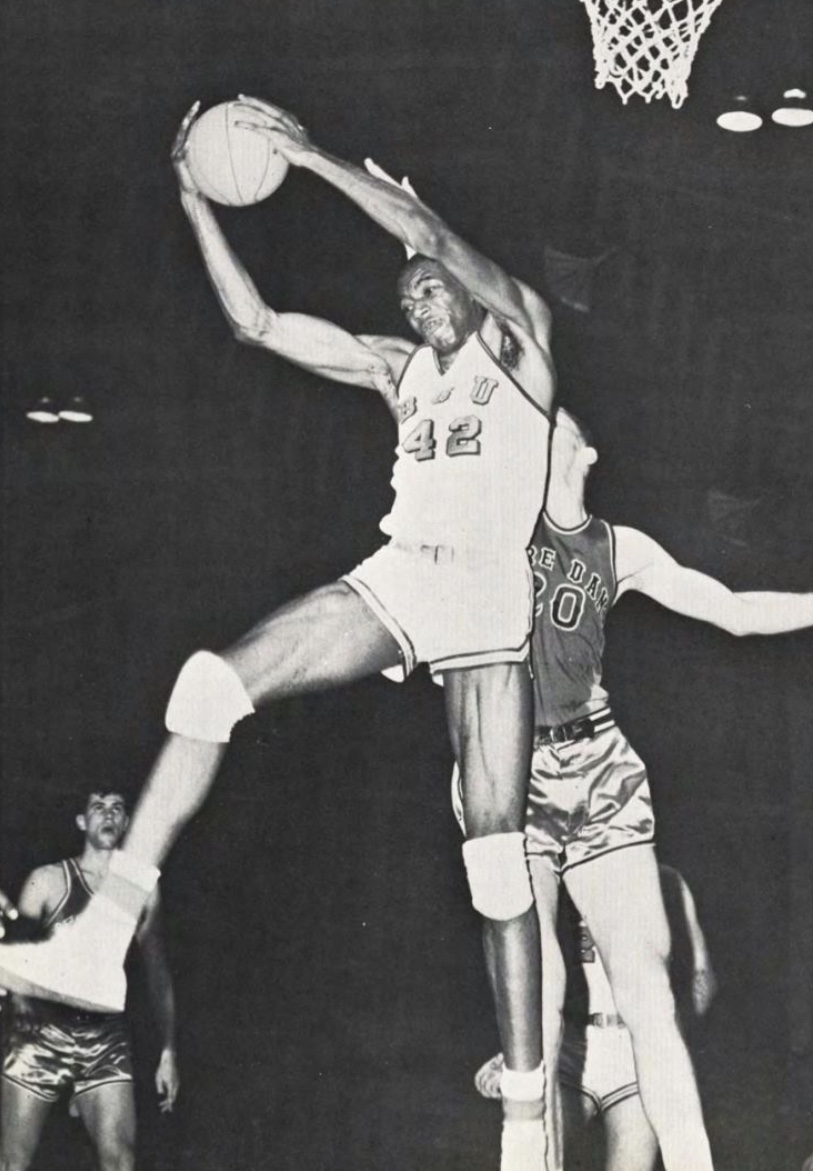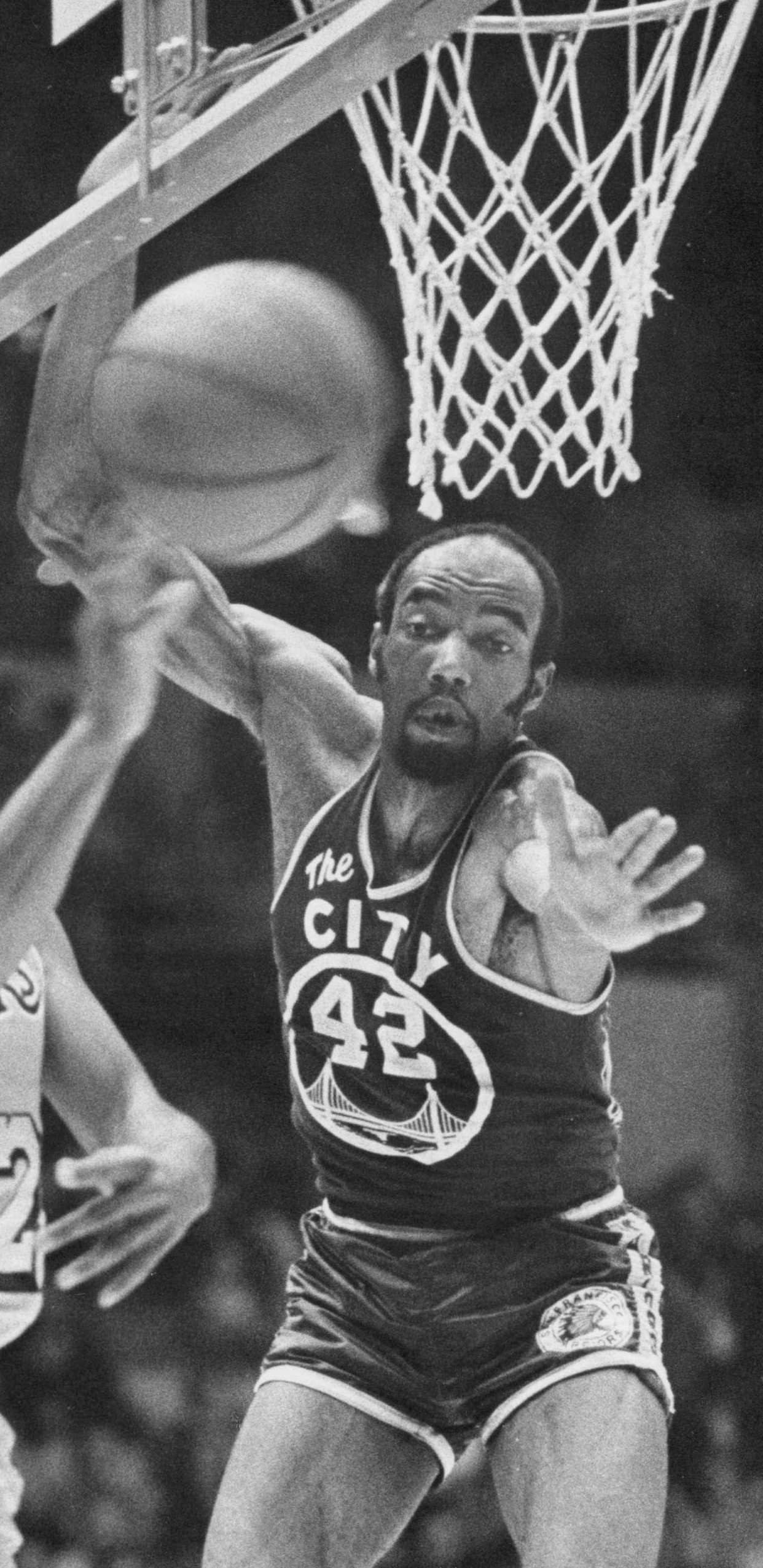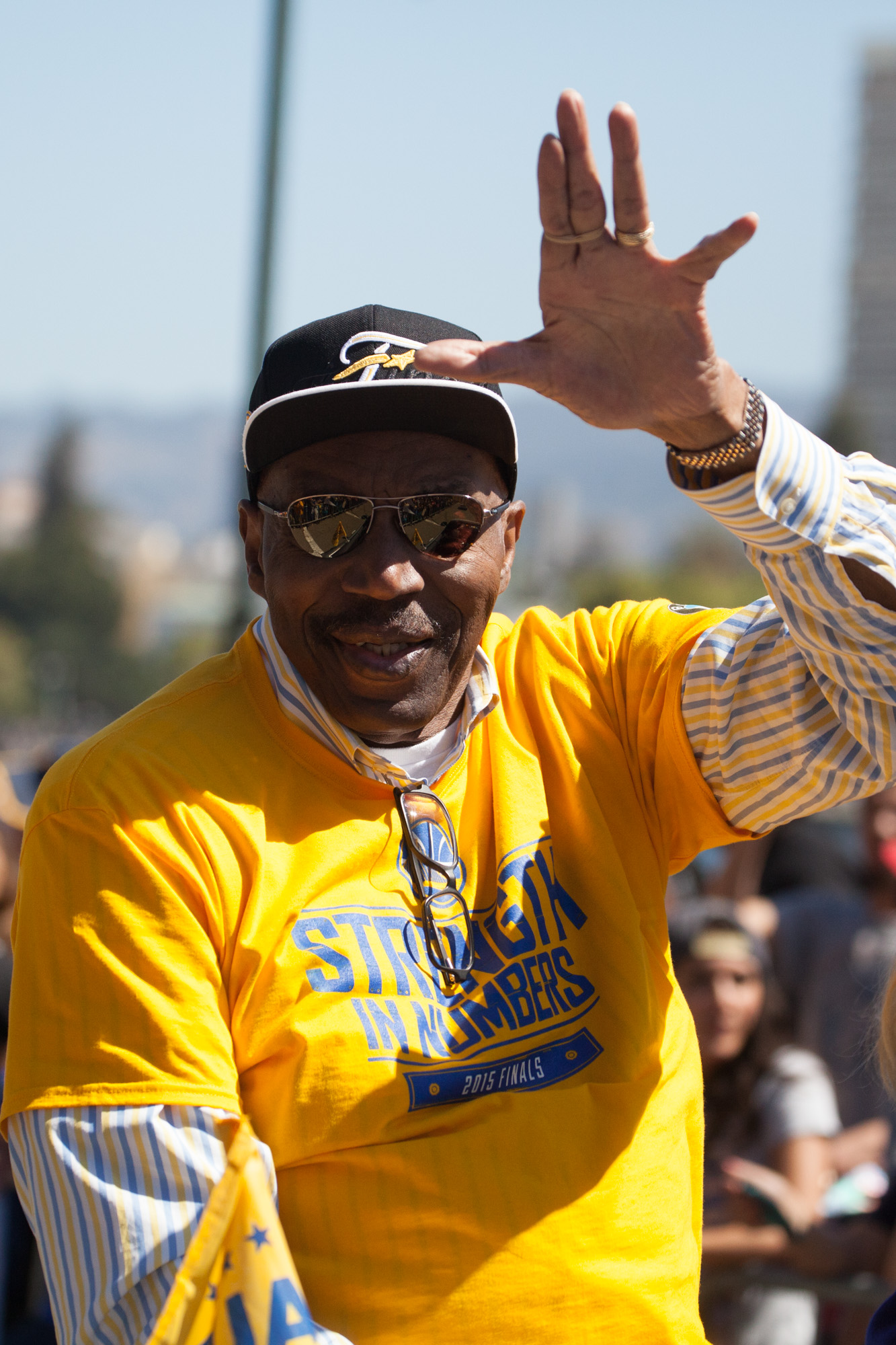1. Overview
Nathaniel Thurmond (July 25, 1941 - July 16, 2016), often known as "Nate the Great", was an American professional basketball player who spent the majority of his 14-year career in the National Basketball Association (NBA) with the Golden State Warriors franchise. Standing 83 in (211 cm) and weighing 225 lb (102 kg), he primarily played the center and power forward positions.
Thurmond was a seven-time NBA All-Star and made history as the first player in NBA history to record an official quadruple-double. In 1965, he achieved 42 rebounds in a single game, a feat surpassed only by Wilt Chamberlain and Bill Russell in NBA history. His exceptional defensive skills earned him a fearsome reputation among opponents. He was inducted into the Naismith Memorial Basketball Hall of Fame in 1985, selected as one of the 50 Greatest Players in NBA History in 1996, and named to the NBA 75th Anniversary Team in 2021. Both the Golden State Warriors and the Cleveland Cavaliers have retired his No. 42 jersey in his honor.
2. Early Life and College
Nathaniel Thurmond was born on July 25, 1941, in Akron, Ohio. He attended Akron Central High School, where he played basketball alongside future NBA star Gus Johnson. During his high school career, Thurmond's team faced off against Jerry Lucas's team in the Ohio state high school playoff finals, where Thurmond's team was defeated.
To avoid becoming a backup to Lucas, who was also a center and had committed to Ohio State University, Thurmond declined a scholarship offer from Ohio State. Instead, he chose to play college basketball at Bowling Green State University. During his three varsity seasons at Bowling Green, Thurmond consistently led the Mid-American Conference in rebounds, averaging 17.8 points and 17.0 rebounds per game throughout his college career. In 1963, he was recognized as a first-team All-American by The Sporting News. In his final two years with Bowling Green, he helped lead the team to appearances in the NCAA Tournament. He set a school record by grabbing 31 rebounds in his final college game.

3. Professional Career
Thurmond's professional career spanned 14 seasons in the NBA, during which he played for three different franchises: the San Francisco/Golden State Warriors, the Chicago Bulls, and the Cleveland Cavaliers.
3.1. San Francisco/Golden State Warriors
Thurmond was selected as the 3rd overall pick by the San Francisco Warriors (now known as the Golden State Warriors) in the 1963 NBA draft. In his rookie season, he primarily played a supporting role alongside the legendary Hall of Fame center Wilt Chamberlain, averaging 7 points and 10.4 rebounds per game. His performance earned him a spot on the NBA All-Rookie Team in 1964.
Following Chamberlain's trade to the Philadelphia 76ers during the 1964-65 season, Thurmond emerged as the Warriors' highly productive starting center. He quickly established himself as a dominant force, setting a regular-season record with 18 rebounds in a single quarter. He averaged 21.3 rebounds per game in the 1966-67 NBA season and 22.0 rebounds per game in the 1967-68 NBA season. In the 1966-67 season, he finished second to Wilt Chamberlain in the NBA MVP voting. Thurmond consistently averaged over 20 points per game each season from 1967-68 through 1971-72 and was selected to seven NBA All-Star Games as a member of the Warriors.
Thurmond also developed a formidable defensive reputation throughout the NBA. Kareem Abdul-Jabbar famously stated that Thurmond was the toughest defender he ever faced during his 20-season professional career. Another NBA All-Star center, Bob Rule, recounted an instance where Thurmond blocked six of his seven shots in the first half of their initial encounter. When his coach urged him to "Keep putting 'em up. He can't block 'em all", Rule responded, "Yeah, well if I hadn't made that layup it would have been all of 'em."
Despite the contributions of star teammates like Rick Barry and Thurmond's consistent, stalwart play at center, the Warriors were unable to secure an NBA championship during his tenure. They reached the 1967 NBA Finals but ultimately lost to Chamberlain's 76ers. Ironically, the Warriors would go on to win their first championship in 1975, the season immediately following Thurmond's trade from the team.
3.2. Chicago Bulls
On September 3, 1974, prior to the 1974-75 NBA season, a 33-year-old Thurmond was traded to the Chicago Bulls in exchange for Clifford Ray and 100.00 K USD. The Bulls sought a singular starting center to replace their three-man rotation of Ray, Tom Boerwinkle, and Dennis Awtrey, while the Warriors gained financial stability from the transaction.
In his debut game as a Bull on October 18, 1974, against the Atlanta Hawks, Thurmond made history by recording the first official quadruple-double in NBA history. He achieved 22 points, 14 rebounds, 13 assists, and 12 blocked shots in the Bulls' 120-115 overtime victory. It is important to note that blocked shots were not officially counted as a statistic in the NBA prior to the 1973-74 season.

3.3. Cleveland Cavaliers
Thirteen games into the 1975-76 NBA season, on November 27, 1975, Thurmond was traded along with Rowland Garrett to the Cleveland Cavaliers in exchange for Steve Patterson and Eric Fernsten. At the time of the trade, Thurmond's playing style, characterized by his mobility, did not align well with the Bulls' offense, which was designed for a more stationary center. This mismatch led to diminished playing time for Thurmond on a team that was experiencing a nine-game losing streak.
In Cleveland, the then 35-year-old Thurmond came off the bench to fill in for the injured Jim Chones. He played a crucial role in leading Cleveland's "Miracle at Richfield" team to the NBA Eastern Conference finals in 1976, where the Cavaliers eventually lost to the Boston Celtics. Thurmond continued to play for the Cavaliers as a role player, with limited minutes and mid-single-digit scoring and rebounding averages, until his retirement at the end of the 1976-77 season.
4. Statistical Accomplishments
Nate Thurmond achieved several notable statistical milestones throughout his NBA career:
- First player in NBA history to record a quadruple-double in a game: On October 18, 1974, in his debut with the Chicago Bulls against the Atlanta Hawks, he recorded 22 points, 14 rebounds, 13 assists, and 12 blocked shots. This achievement was particularly significant as blocked shots were not officially recorded in the NBA prior to the 1973-74 season. Only Alvin Robertson, Hakeem Olajuwon, and David Robinson have since achieved a quadruple-double.
- One of five players in NBA history to average at least 15 rebounds per game for his career: He finished his career with an average of 15.0 rebounds per game, ranking 5th all-time (14,464 rebounds in 964 games, ranking 10th all-time). The other players to achieve this are Wilt Chamberlain, Bill Russell, Bob Pettit, and Jerry Lucas.
- One of five players in NBA history to average at least 20 rebounds per game during a season: He achieved this twice, averaging 21.3 rebounds per game in the 1966-67 season and 22.0 rebounds per game in the 1967-68 season. The other players to accomplish this feat are Bill Russell, Wilt Chamberlain, Bob Pettit, and Jerry Lucas.
- One of four players in NBA history to record 40 or more rebounds in a game: On November 9, 1965, he recorded 42 rebounds against the Detroit Pistons. The only other players to achieve 40+ rebounds in a game are Bill Russell, Wilt Chamberlain, and Jerry Lucas.
- NBA regular season record for rebounds in a quarter: He recorded 18 rebounds in a single quarter against the Baltimore Bullets on February 28, 1965.
- Golden State Warriors franchise record for total rebounds: He holds the franchise record with 12,771 career rebounds.
5. NBA career statistics
5.1. Regular season
| Year | Team | GP | GS | MPG | FG% | 3P% | FT% | RPG | APG | SPG | BPG | PPG |
|---|---|---|---|---|---|---|---|---|---|---|---|---|
| 1963-64 | San Francisco | 76 | - | 25.9 | .395 | - | .549 | 10.4 | 1.1 | - | - | 7.0 |
| 1964-65 | San Francisco | 77 | - | 41.2 | .419 | - | .658 | 18.1 | 2.0 | - | - | 16.5 |
| 1965-66 | San Francisco | 73 | - | 39.6 | .406 | - | .654 | 18.0 | 1.5 | - | - | 16.3 |
| 1966-67 | San Francisco | 65 | - | 42.5 | .437 | - | .629 | 21.3 | 2.6 | - | - | 18.7 |
| 1967-68 | San Francisco | 51 | - | 43.6 | .411 | - | .644 | 22.0 | 4.2 | - | - | 20.5 |
| 1968-69 | San Francisco | 71 | - | 45.2 | .410 | - | .615 | 19.7 | 3.6 | - | - | 21.5 |
| 1969-70 | San Francisco | 43 | - | 44.6 | .414 | - | .754 | 17.7 | 3.5 | - | - | 21.9 |
| 1970-71 | San Francisco | 82 | - | 40.9 | .445 | - | .730 | 13.8 | 3.1 | - | - | 20.0 |
| 1971-72 | Golden State | 78 | - | 43.1 | .432 | - | .743 | 16.1 | 2.9 | - | - | 21.4 |
| 1972-73 | Golden State | 79 | - | 43.3 | .446 | - | .718 | 17.1 | 3.5 | - | - | 17.1 |
| 1973-74 | Golden State | 62 | - | 39.7 | .444 | - | .666 | 14.2 | 2.7 | .7 | 2.9 | 13.0 |
| 1974-75 | Chicago | 80 | - | 34.5 | .364 | - | .589 | 11.3 | 4.1 | .6 | 2.4 | 7.9 |
| 1975-76 | Chicago | 13 | - | 20.0 | .444 | - | .444 | 5.5 | 2.0 | .3 | .9 | 3.7 |
| 1975-76 | Cleveland | 65 | - | 17.4 | .418 | - | .514 | 5.3 | 1.0 | .3 | 1.3 | 4.6 |
| 1976-77 | Cleveland | 49 | - | 20.3 | .407 | - | .642 | 7.6 | 1.7 | .3 | 1.7 | 5.5 |
| Career | 964 | - | 37.2 | .421 | - | .667 | 15.0 | 2.7 | .5 | 2.1 | 15.0 | |
| All-Star | 5 | 2 | 20.8 | .326 | - | .375 | 8.8 | .4 | .0 | .0 | 6.2 | |
5.2. Playoffs
| Year | Team | GP | GS | MPG | FG% | 3P% | FT% | RPG | APG | SPG | BPG | PPG |
|---|---|---|---|---|---|---|---|---|---|---|---|---|
| 1964 | San Francisco | 12 | - | 34.2 | .438 | - | .679 | 12.3 | .8 | - | - | 10.0 |
| 1967 | San Francisco | 15 | - | 46.0 | .433 | - | .571 | 23.1 | 3.1 | - | - | 15.9 |
| 1969 | San Francisco | 6 | - | 43.8 | .392 | - | .588 | 19.5 | 4.7 | - | - | 16.7 |
| 1971 | San Francisco | 5 | - | 38.4 | .371 | - | .800 | 10.2 | 3.0 | - | - | 17.6 |
| 1972 | Golden State | 5 | - | 46.0 | .434 | - | .750 | 17.8 | 5.2 | - | - | 25.4 |
| 1973 | Golden State | 11 | - | 41.8 | .398 | - | .800 | 13.2 | 3.6 | - | - | 14.5 |
| 1975 | Chicago | 13 | - | 19.5 | .368 | - | .486 | 6.7 | 2.4 | .4 | 1.6 | 3.5 |
| 1976 | Cleveland | 13 | - | 28.8 | .468 | - | .406 | 9.0 | 2.2 | .5 | 2.2 | 6.7 |
| 1977 | Cleveland | 1 | - | 1.0 | - | - | - | 1.0 | .0 | .0 | 1.0 | .0 |
| Career | 81 | - | 35.5 | .416 | - | .621 | 13.6 | 2.8 | .4 | 1.9 | 11.9 | |
6. Personal Life and Post-Retirement
After retiring from professional basketball, Nate Thurmond returned to San Francisco and established his own restaurant, "Big Nate's BBQ". He operated the restaurant for 20 years before selling it. He resided in San Francisco with his wife, Marci. As of 2019, the Chase Center, the home arena for the Golden State Warriors, features a "Big Nate's BBQ" kiosk, offering dishes that serve as a tribute to his distinguished career. The regularly played on basketball courts in Golden Gate Park are also named after the Warriors legend.
Thurmond was also honored by the Warriors organization with the title of "Warriors Legend & Ambassador," a role in which he continued to represent the team.

7. Death
Nate Thurmond passed away on July 16, 2016, at the age of 74, just nine days before his 75th birthday. His death followed a brief battle with leukemia. In recognition of his legacy, the Golden State Warriors paid homage to Thurmond during the 2016-17 NBA season by featuring his jersey number, 42, as a patch on their uniforms.
8. Legacy and Recognition
Nate Thurmond's profound impact on the sport of basketball has been widely recognized through numerous accolades and honors. He was inducted into the Naismith Memorial Basketball Hall of Fame in 1985, solidifying his place among the game's greatest. In 1996, he was selected as one of the 50 Greatest Players in NBA History, and in 2021, he was further honored as a member of the NBA 75th Anniversary Team.
His defensive excellence was also recognized with selections to the NBA All-Defensive Team, earning First Team honors twice (1969, 1971) and Second Team honors three times (1972, 1973, 1974).
Known affectionately by fans as "Nate the Great", his jersey number 42 has been permanently retired by two NBA franchises: the Golden State Warriors and the Cleveland Cavaliers, a testament to his significant contributions to both teams. Thurmond is particularly remembered for his exceptional defensive prowess and his rebounding dominance, often being compared to other legendary defensive players of his era.